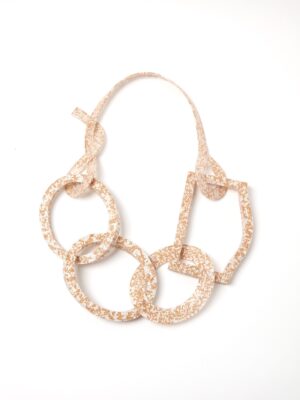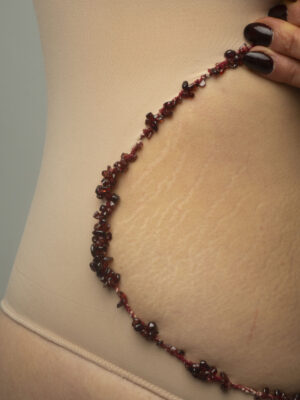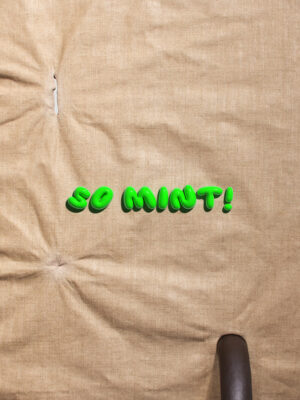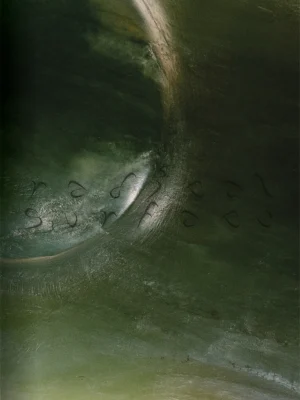Nina Moog: How long have you been working in this studio?
Joohee Han: This is my first studio, and I got it before my graduation. At the beginning of the first lockdown in the spring, I spent most of my time building things for the studio. I knew I wanted a drawing table and workbench, as well as a free space to do whatever I want. I built this working bench and this desk myself during April and May. I built the shelves, as well a dividing wall.
NM: Was the creation of your studio your main focus during lockdown?
JH: I suppose so. At the beginning, it was so difficult to concentrate because everything was closed and there was no stimulation. It was very hard to start working! When all the shops were closed in Germany, the hardware stores were still allowed to be open, which was really fortunate too that I could build my studio — from small screws to big pieces of wood. The most beautiful thing in my studio is that we have really high ceiling. It’s almost five meters high, so I thought i could use that space to store things. So I planned to build wall shelves, which was really a pain in the ass at the end, it involved so much drama. It was really hard to drill into the wall, because the walls are made of concrete. It felt like drilling on the stone. And I have a fear of heights. I had to climb up the ladder and drill with all the strength I could. When it was finished, I felt like my body would fall apart. I’m really proud of myself, and satisfied. The other thing I really like is my goldsmith bench, which I also built myself and customized.

NM: Let’s talk about the work you showed at Lee Eugean Gallery in December and January 20/21, which was part of your Oval series. These pieces are made of silicon and eggshell, and continue a series you made as part of your graduation at the Akademie. What continues to attract you to this technical and conceptual idea? I found the idea of addressing perfection through eggs something I could immediately connect to.
JH: Throughout my work, there is a consistent interest in fragility. This series is about the awareness that we’re fragile, and that we’re not perfect. A main difference for this series was my working method. During my study in Korea, I experimented with the material – I didn’t always have a concrete idea in the beginning of making things. For Oval, I had a concept, and I had the material, but my process wasn’t about experiencing or exploring the material. It was more like I wanted to enable my idea. This also meant, however, that the resulting work was more expected. I knew it would become like this. Therefore, there is no aesthetic, technical, conceptual development among the pieces. I thought about it, had an idea, I researched how to realise the idea, and that’s what I made. The newer work in the series is therefore more flexible, more entangled. My graduation project consists of brooches, but they also look like objects when they stand on the table. Then I started to make necklaces because they have more body contact.
NM: Why is it important to you that your work be worn, or close to the body?
JH: None of my work is really ‘wearable’, but that depends on how you define wearability. You can wear my pieces, but they are not for everyday. My work is more about the experience of it. An earlier piece of mine is a huge bracelet called Bubble. You cannot wear it in daily situation, because it will restrict your behaviour. This bracelet can control you. You have to move your arm very carefully, as if you’re carrying a soap bubble that you don’t want to burst. It gives you body awareness and insight into how you move. You can hurt things quite easily, and you can be brutal. I wanted to express this through jewellery, through the wearing of it. Wearability is a big topic because as you experience more experimental work that challenges the confines of contemporary jewellery, the piece often becomes less and less wearable. This can create a contradiction, but it’s also what makes the field so interesting to me.
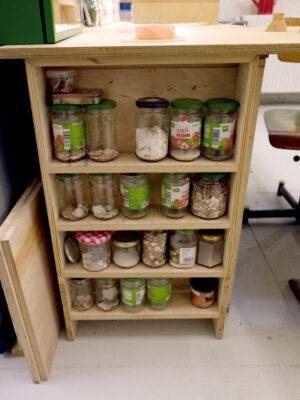
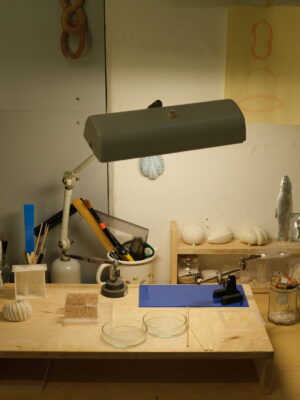
NM: Could you share a little bit about how you realized that eggshells and silicon was the right material for this project?
JH: Silicon is very important to the work, because it makes things possible that eggshell alone cannot offer. Eggshells on their own don’t have flexibility, and that was one of the core ideas of this series. We are under constant stress that we have to be someone other than who we are, so I wanted the eggshell to be flexible.
NM: How do you go about creating these pieces? In my imagination, first, you eat an egg…
JH: Yes, first I eat an egg and crush the shell. Then, I sort out small and big pieces. I collect and sort the shells in glass dishes, by colour. I usually also make a model before I start. When it’s a curvy shape, I curve it out of Styrofoam but if it has clear, hard edges, I use a paper mould. Then, I make the same shape with a plastic sheet. If it’s a curvy form, I use the vacuum forming machine. Once I have a mould, I can put silicon on the inside of the mould to make a negative form. I put about two centimeters on the surface, and then place eggshells very carefully, one by one.
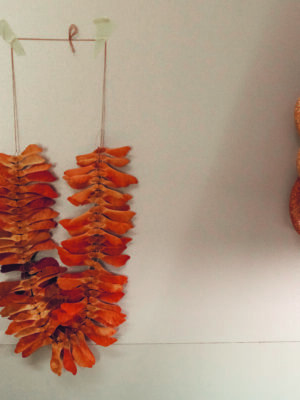
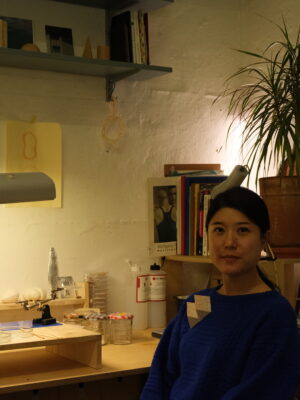
NM: Do you have to work very quickly?
JH: Yes, I can get about two by two centimeters done in twenty minutes. The drying time of silicon determines how fast I can go. When it’s all done, I put another layer all over to strengthen it, and the eggshell rests in the middle of a silicon layer. When I was making brooches, I also created my own brooch pin-back. The usual brooch pin-back doesn’t work in this case, since those involve tension in order to close. I didn’t want to add anything at all besides eggshell and silicon. I wanted to retain the flexibility, which was significant for my concept, so I had to come up with a different mechanism.
NM: Your newest work involves using both sides of the eggshell, where you play with colour gradation.
JH: In the beginning, I was avoiding any aesthetic experimentation. I wanted to stay focused on the initial idea. After graduation, I gave myself freedom to play. I really like the result because you can better understand the material from looking at it. Before, many people were confused with the material and thought it was cork. This was a big problem for me. Lately, there haven’t been many opportunities to show the work physically. Viewed only online, it’s so difficult to understand the material.
NM: As a final note, do you have any role models within jewellery? Who inspires you?
JH: I love looking at the work from design studios, from product design to furniture and interiors. I really like the projects from Studio Swine; when I saw the work “Hair Highway” and “Sea chair” for the first time, I fell in love with their aesthetic and the method of making. I found projects they do were just so emotionally convincing and creative, visually and technically. I also like English furniture designer Max Lamb, whose furniture pieces are so intriguing, not just because of the result but also his making process and material choice. Korean designer Kwangho Lee who also has background in metalsmithing and jewellery. His approach to furniture is based on craftsmanship, although many of his works are commercially successful. As a maker and someone who has a similar educational background, it is interesting to me how he has forged his career in the both of market of design and the art scene at the same time in Korea and internationally. When I have questions about the making process and materials of my work, if it’s sustainable and relevant to our time now, these are some of the people I turn towards.
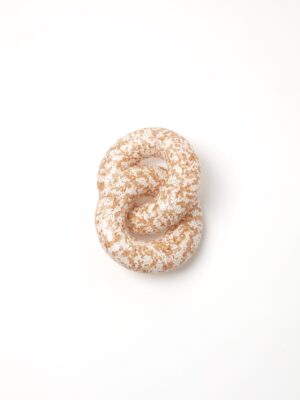
Joohee Han is a South Korean jewellery designer. She graduated from the Akademie Der Bildenden Künste München in Prof. Karen Pontoppidan’s class. Her work has been most recently exhibited in the Lee Eugean Gallery in Seoul. Previous exhibitions include Oval, a solo exhibition at Atelier Ursula Sunkler (2020) as well as a Meme, a group show at the Galerie Maurer Zilioli. (2020) You can find more of her work at www.jooheehan.com
